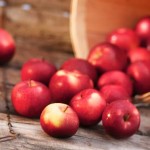This week, read about what’s lurking in your receipts, how to create effective practices, looking beyond beets for nitrates, and more.
 Receipts and Greasy Fingers, Is it a Problem?
Receipts and Greasy Fingers, Is it a Problem?
Thermal receipt paper from supermarkets, ATM machines, gas stations, and other settings is a source of BPA exposure. BPA is a hormone disruptor that might have adverse health effects. New research shows that certain conditions can dramatically increase BPA absorption. Scientists mimicked a food court scenario: people used hand sanitizer, held a cash register receipt, and then ate French fries: they found that these people were quickly exposed to high levels BPA (a hormone-disrupting chemical). Study authors are calling for alternate technology for receipts. (Time, PLOS One October 22, 2014).
How much do you need to worry about the BPA in cash register receipts? Although this new study provides more data to advance the science of BPA exposure, it is unlikely that the hand sanitizer and receipt-holding pattern used in the study is typical. Read a good review of this study and potential risk here.
A Quick Cure for Ineffective Practice
What causes a bad practice? It’s easy to say that players/athletes/children aren’t engaged, but more important to look at the practice design. The video below presents a great visual of how an ineffective space can present challenges that zap enthusiasm and prompt learners to lose interest. Seems this concept might be generalized to many situations beyond athletics. (The Talent Code)
Beets Benefit Athletes and Heart Failure Patients
The research on beets continues to reveal the health-promoting properties of dietary nitrate, with one of the latest studies showing that beet juice can increase blood flow to fast-twitch muscle fibers. These researchers also suggest that beet juice might improve the quality of life for heart failure patients by increasing oxygen delivery to muscles. (Nitric Oxide, October 2014).
I have written about earlier research on beets and endurance here. Most of the studies use beet juice, likely because it’s consistent with other studies, has stable nitrate levels, and has a good placebo (nitrate-free beet juice). But other nitrate-containing vegetables might have similar benefits: One study found that a diet rich in traditional Japanese foods (plenty of leafy greens) increased plasma nitrite levels and lowered blood pressure, showing that high-nitrate vegetables other than beets may also increase nitric oxide levels.
Vegetables high in nitrates include rhubarb, arugula, spinach, celery, cress, chervil, lettuce, beets, chinese cabbage, endive, fennel, kohlrabi, leek, and parsley (levels vary depending on soil conditions and other variables, but the table below provides approximate nitrate content).
 IN SEASON: Apples
IN SEASON: Apples
In most areas, it’s a great time to enjoy apples at their peak. Find out more about the health benefits of this versatile fruit.
More links of interest this week:
- In Defense of the Weekend-Warrior Lifestyle. Any exercise is better than none! (The Atlantic)
- Beware the Single-Study Story. Nice article explaining why you need to be skeptical when reading research headlines. (Outside) Beyond single studies, also be aware of articles or books that “cherry pick” studies. That is, presenting only information that supports your ideas. Wheat Belly is a good example of a book with health recommendations based on cherry picked data (and many other pseudoscientific arguments).
- Gluten-free market booming, but researchers aren’t sold. CBC Marketplace looks at the gluten-free trend. The multiple claims for avoiding gluten aren’t supported by science, and the idea that gluten sensitivity is widespread goes far beyond the current scientific evidence.
- Got 7 minutes? Try this 7-minute workout (New York Times Well, Gretchen Reynolds). There’s a phone/web app here. Looks good!
- Everything You Need to Know About Endurance Training in One Race! How varied approaches to endurance training lead to success. (Michael J. Joyner, Human Limits).
 How Music Can Boost a High-Intensity Workout. Interval training is hard; in this study, music didn’t dampen that perception, but increased the power produced during intervals. (Gretchen Reynolds, New York Times; Med Sci Sports Exercise, September 2014).
How Music Can Boost a High-Intensity Workout. Interval training is hard; in this study, music didn’t dampen that perception, but increased the power produced during intervals. (Gretchen Reynolds, New York Times; Med Sci Sports Exercise, September 2014).
- Equating Treadmill and Outdoor Running. Good info, especially if you think you should set the treadmill at 1% incline. (Matt Fitzgerald, Active.com)
- Athletes and blood clots: one runner’s story. (Runners World). Several factors put athletes at risk for deep vein thrombosis. Here’s a good resource for athlete-specific risk factors and prevention of blood clots.
- Resetting the circadian clock: Shift workers might want to skip high-iron foods. Iron disrupts the liver’s circadian clock, predisposing mice to metabolic syndrome (which is more prevalent in shift workers). (Diabetes, October 2014).
- Twenty tips for interpreting scientific claims. An excellent list to help non-scientists understand the limitations of scientific evidence. (Nature, November 2013)
